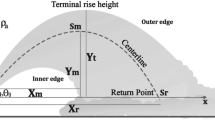Abstract
Turbulent mixing of an inclined, skewed jet injected into a crossflow is investigated using MRI-based experiments and a high-fidelity LES of the same configuration. The MRI technique provides three-dimensional fields of mean velocity and mean jet concentration. The 30° skew of the jet relative to the crossflow produces a single dominant vortex which introduces spanwise asymmetries to the velocity and concentration fields. The turbulent scalar transport of the skewed jet is investigated in further detail using the LES, which is validated against the experimental measurements. Mixing is found to be highly anisotropic throughout the jet region. Isotropic turbulent diffusivity and viscosity are used to calculate an optimal value of the turbulent Schmidt number, which varies widely over the jet region and lies mostly outside of the typically accepted range 0.7 ≤ S c t ≤ 0.9. Finally, three common scalar flux models of increasing complexity are evaluated based on their ability to capture the anisotropy and predict the scalar concentration field of the present configuration. The higher order models are shown to better represent the turbulent scalar flux vector, leading to more accurate calculations of the concentration field. While more complex models are better able to capture the turbulent mixing, optimization of model constants is shown to significantly affect the results.













Similar content being viewed by others
References
Aga, V., Abhari, R.S.: Influence of flow structure on compound angled film cooling effectiveness and heat transfer. J. Turbomach. 133(3), 031,029 (2011)
Khan, Z.U., Johnston, J.P.: On vortex generating jets. Int. J. Heat Fluid Flow 21(5), 506–511 (2000)
McGovern, K., Leylek, J.: A detailed analysis of film cooling physics: Part iicompound-angle injection with cylindrical holes. J. Turbomach. 122(1), 113–121 (2000)
Johnson, P.L., Kapat, J.S.: Large-eddy simulations of a cylindrical film cooling hole. J. Thermophys. Heat Transfer 27(2), 255–273 (2013)
Ziefle, J., Kleiser, L.: Assessment of a film-cooling flow structure by large-eddy simulation. J. Turb. 9, N29 (2008)
Walters, D.K., Leylek, J.H.: A systematic computational methodology applied to a three-dimensional film-cooling flowfield. J. Turbomachinery 119(4), 777–785 (1997)
Ivanova, E.M., Noll, B.E., Aigner, M.: A numerical study on the turbulent schmidt numbers in a jet in crossflow. J. Eng. Gas Turb. Power 135(1), 011,505 (2013)
Daly, B.J., Harlow, F.H.: Transport equations in turbulence. Phys. Fluids 13(11), 2634–2649 (1970)
Abe, K., Suga, K.: Towards the development of a Reynolds-averaged algebraic turbulent scalar-flux model. Int. J. Heat Fluid Flow 22(1), 19–29 (2001)
Rossi, R., Iaccarino, G.: Numerical simulation of scalar dispersion downstream of a square obstacle using gradient-transport type models. Atmosph. Environ. 43(16), 2518–2531 (2009)
Ling, J., Ryan, K.J., Bodart, J., Eaton, J.K.: Analysis of turbulent scalar flux models for a discrete hole film cooling flow. J. Turbomach. 138(1), 011,006 (2016)
Li, X., Qin, Y., Ren, J., Jiang, H.: Algebraic anisotropic turbulence modeling of compound angled film cooling validated by particle image velocimetry and pressure sensitive paint measurements. J. Heat Transfer 136(3), 032,201 (2014)
Azzi, A., Lakehal, D.: Perspectives in modeling film cooling of turbine blades by transcending conventional two-equation turbulence models. J. Turbomach. 124(3), 472–484 (2002)
Pelc, N., Sommer, F., Li, K., Brosnan, T., Herfkens, R., Enzmann, D.: Quantitative magnetic resonance flow imaging. Magn. Resonan. Quart. 10(3), 125–147 (1994)
Benson, M.J., Elkins, C.J., Mobley, P.D., Alley, M.T., Eaton, J.K.: Three-dimensional concentration field measurements in a mixing layer using magnetic resonance imaging. Exper. Fluids 49(1), 43–55 (2010)
Bodart, J., Coletti, F., Bermejo-Moreno, I., Eaton, J.K.: High-fidelity simulation of a turbulent inclined jet in a crossflow. Center for Turbulence Research annual research brief, Stanford University, Stanford, CA (2013)
Vreman, A.: An eddy-viscosity subgrid-scale model for turbulent shear flow: Algebraic theory and applications. Phys. Fluids 16(10), 3670–3681 (2004)
Acknowledgments
The authors gratefully acknowledge financial support from Honeywell Aerospace and ANSYS, Inc. J. B. and M. F. would like to thank continuous support and computational resources provided by CNRS on Turing (GENCI-IDRIS, Grant x20152a7178) and Eos (CALMIP, Grant 2015-p1425).
Author information
Authors and Affiliations
Corresponding author
Rights and permissions
About this article
Cite this article
Ryan, K.J., Bodart, J., Folkersma, M. et al. Turbulent Scalar Mixing in a Skewed Jet in Crossflow: Experiments and Modeling. Flow Turbulence Combust 98, 781–801 (2017). https://doi.org/10.1007/s10494-016-9785-7
Received:
Accepted:
Published:
Issue Date:
DOI: https://doi.org/10.1007/s10494-016-9785-7




